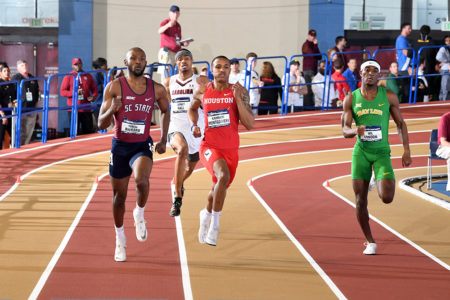 IF YOU’RE A BIG FAN of 1-lap racing—and who among us isn’t?—you’ll love this month’s edition, as we check out Michael Norman working some serious magic, have a nice long chat with Fred Kerley and analyze the overall U.S. men’s scene in the event.
IF YOU’RE A BIG FAN of 1-lap racing—and who among us isn’t?—you’ll love this month’s edition, as we check out Michael Norman working some serious magic, have a nice long chat with Fred Kerley and analyze the overall U.S. men’s scene in the event.
There’s no question that the 400—men or women—is one of my favorite running events, simply because it’s the longest event where people are running so close to all-out for such an extended period of time. I’ve never quite understood how quartermilers can push themselves to the limit so much and not end up inspecting the contents of their stomach right after the race. That’s certainly the memory this triple jumper took away from his times being drafted for 4×4 duty. So my giving the 400 “favorite” status is fan-related. It’s not something I’d like to actually do on a regular (or even irregular) basis.
But the headline to this column says the 400 could be better. It’s all about lanes and head-to-head racing, as opposed to being stuck alone. As a backdrop to that statement, let me digress and refer you to the ’76 Olympic 800, which featured one of the IAAF’s most ill-conceived rule changes ever: the 2-turn stagger. That’s right, instead of breaking for the pole after the first curve, they stayed in lanes until they entered the homestretch, meaning that instead of fighting for position after 100m they went head-to-head only after 300m had expired. Almost 40% of the race had all the drama sucked out of it. Fortunately, that protocol was quickly consigned to the garbage heap of history.
the 400 should be run like the 800, with a break to the pole after the first 100m.
If the 800 was improved by having everybody run together longer, doesn’t it follow that the 400 could similarly benefit? As it is, too many 400s are simply too hard for the fans to follow, even if there’s an ace announcer who is able to do a good job of sorting out who’s ahead of whom in the staggers. Not until the race enters the homestretch—after 75% of the race has been run—is relative position confirmed. I think the fans deserve better. And so do the athletes, who are spread out across 8 or 9 lanes and have little idea where their competition is.
My take? As I’ve suggested in this space before, the 400 should be run like the 800, with a break to the pole after the first 100m. Yes, the 400 people are probably bigger, stronger—and definitely running faster—than the halfmilers, and while I’m not advocating that we create a martial arts division, a little more close-quarters running would provide a lot more excitement. Look at how short-track speedskating became an instant sensation in the Winter Olympics. I think the athletes would find it a much fairer way to race too, given that the lane draw goes such a long way towards deciding who finishes where. If it turns out that this creates a too-rough situation, simply cut the number of racers from 8 to 6.
And while we’re tinkering with the 400, let’s extend the lanes-are-bad concept to the 4×4 as well. That race, it says here, lost some of its excitement when the 3-turn stagger was introduced. Not only does that necessitate such a big differentiation in staggers that the first leg is nigh on impossible for a fan to figure out until the actual handoffs, but it also robs the race of another 100m of what should be serious head-to-head racing. Go back to the 2-turn stagger (or, following my individual 400 thinking, a 1-turn stagger).
But that’s not all. Current rules mandate that the athletes receiving the baton line up in the order of their teams when they enter the final bend. That’s nuts. There’s no end of changing positions with half the carry still to go. At worst, the order should be determined as they enter the straightaway, but my druthers would be—as it was in the wild, wild west—to let the runners continue to sort themselves out until the very last seconds before the handoff. Injecting more life into any event is nothing but a good thing.
My oft-stated solution to making the 400 more exciting without running the risk of turning it into Roller Derby is to change the event from a 400 to a 500. I can only imagine that most of the athletes would hate it (uh, oh—here comes breakfast as well as lunch!), but I can see it as a fan favorite. A staggered start at the 100 line, breaking for the pole at the curve and running an entire lap not in lanes.
Meanwhile, there may be a better way to do it, but who among us isn’t tingling with anticipation as the race for the first sub-43 has ramped up a notch? □






